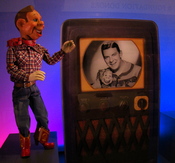Excellent essay on commercialism in our society -
Television is populated with images which are superficial and lack depth. Programs look more like ads and ads look more like programs. All this leads to a close circle of consumerism. The three excerpts relate to these unifying ideas thus the validity of their argument.
'Surface is all; what you see is what you get. These images are proud of their standing as images. They suggest that the highest destiny of our time is to become cleansed of depth and specificity altogether.' (1). We live in a world populated by images. Children's television has concocted small, preset groups of images such as rainbows for happiness, red hearts for warmth, unicorns for magical regeneration, and blondness to indicate superiority ( 2). Images are just that--images which keep the viewer on a superficial level. For instance, in the program Sailor Moon, little girls are kept on a level of clothes and being cute for boys.
This is a very unrealistic outlook and short circuits any thoughts of importance in their lives. Barbie, the Mattel doll, also portrays a false image. With her petite, fragile figure, large bust, tiny waist, long legs, big eyes, and vast career ranging from a lifeguard to a doctor, Barbie wins the hearts of many innocent little girls who become subjected to her unrealistic image.
Most often in television there is no depth beyond the surface, what you see is what you get. This is very prominent in children' s television, where without the special effects in action- adventure shows, all that is left are shows that lack enthusiasm. For example, many children's programs are alike. They often involve very innocent, sweet, high-voiced creatures that live in happy land. They are threatened by bad people who capture one of the...


